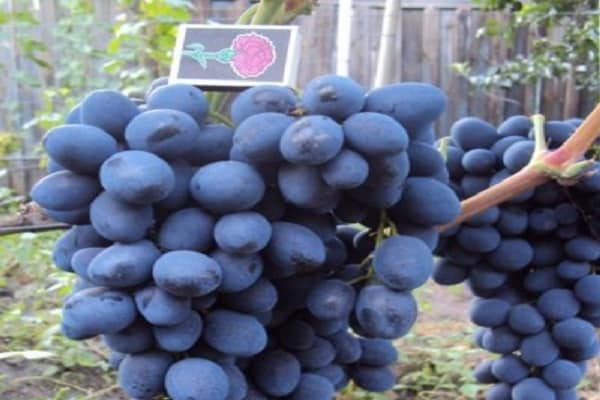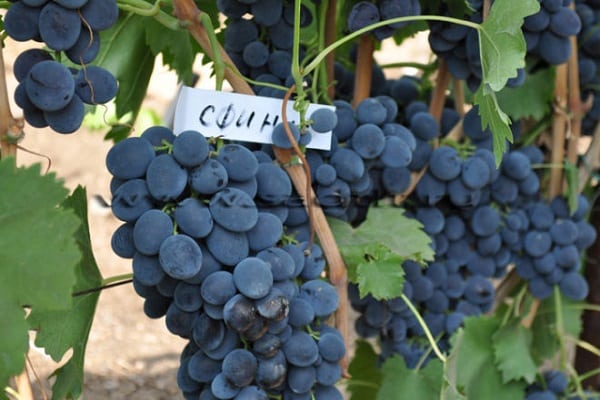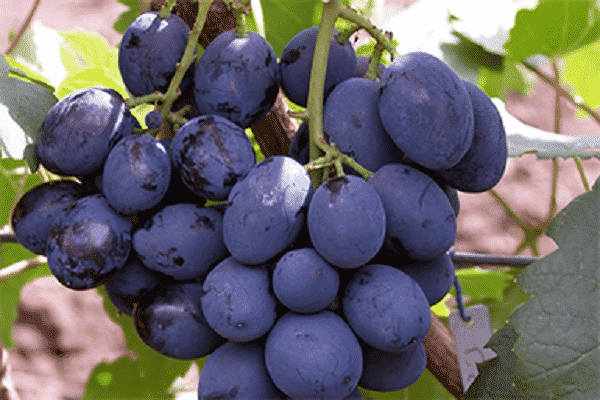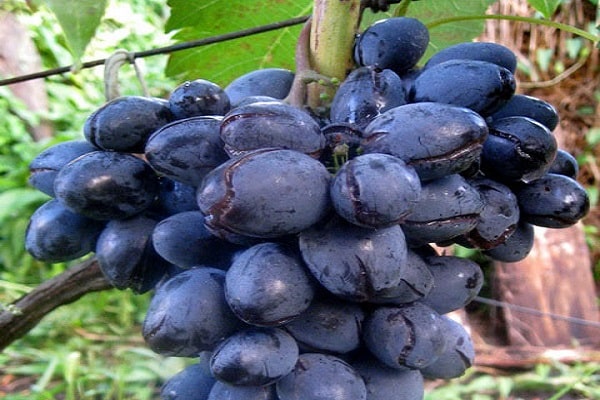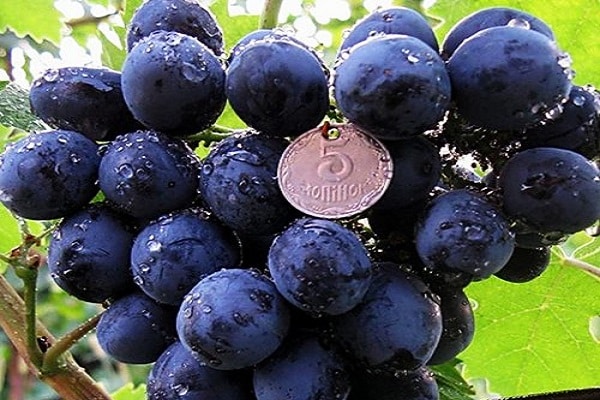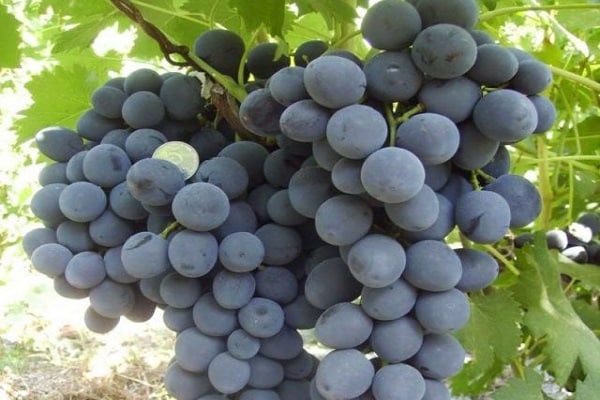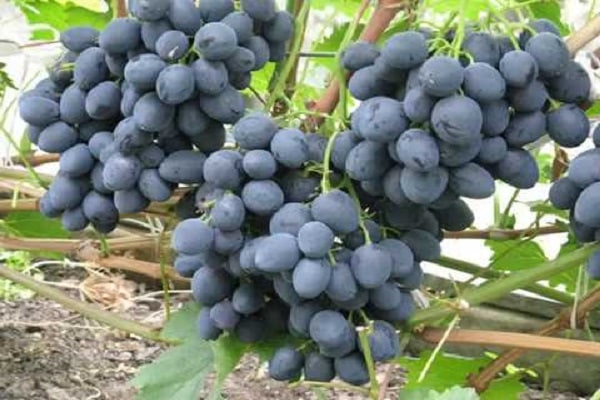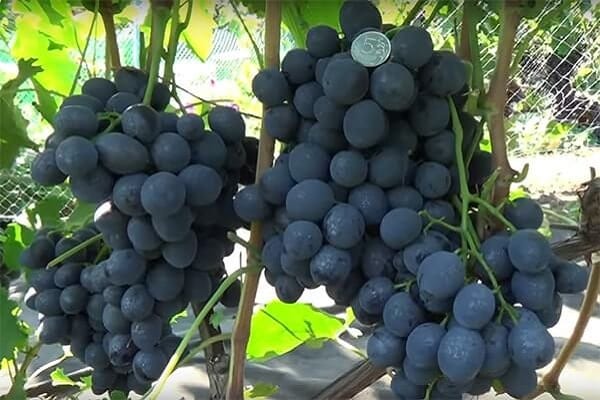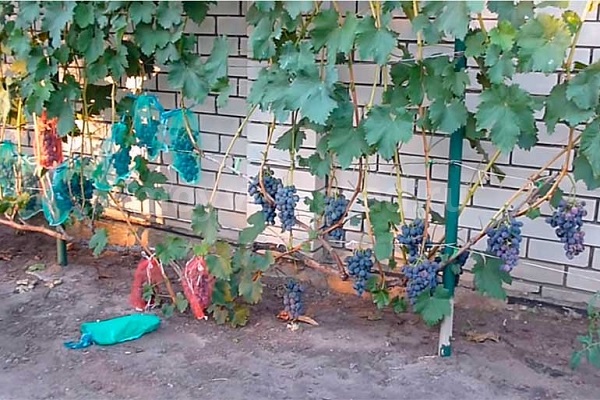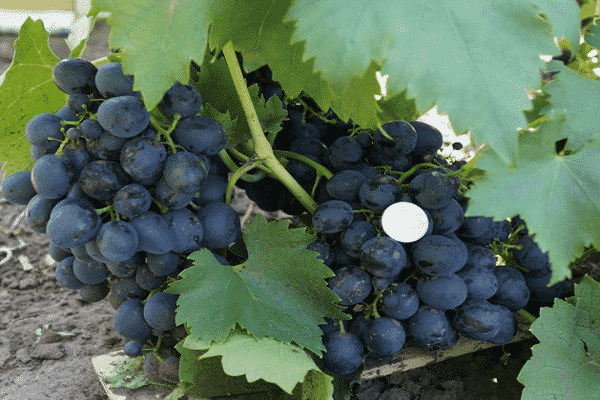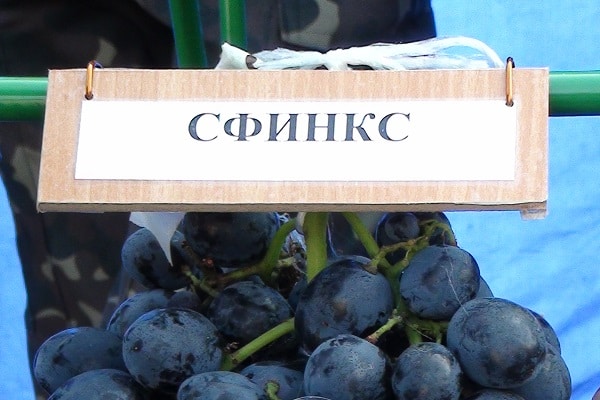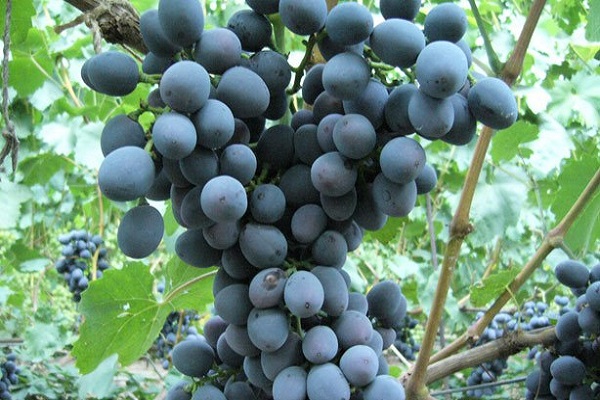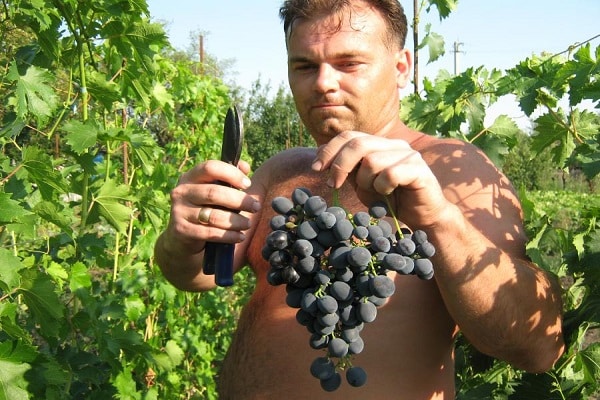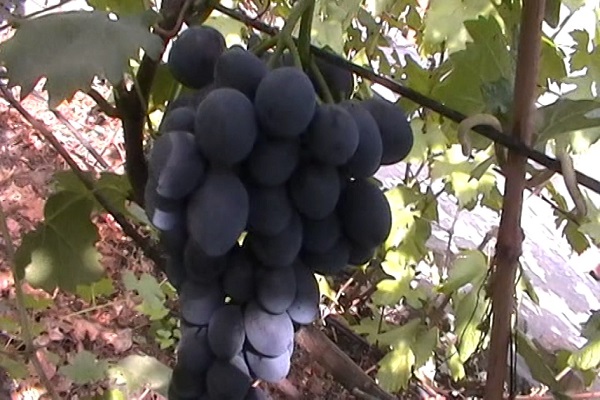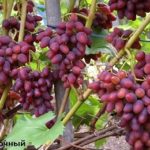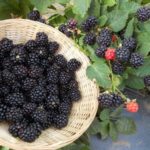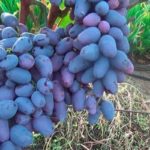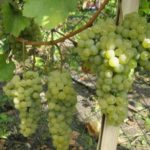The Sphinx grape variety is a table variety, and even a novice gardener can grow it, since the plant is unpretentious in care. The taste of the berries and yield indicators are decent, but there are a number of disadvantages. Good fruiting can be achieved by knowing how to properly plant and care for garden crops.
- History of the appearance of the variety
- Characteristics and external indicators
- Growing area
- Frost resistance
- Disease resistance
- What does the bush and shoots look like?
- Fruits and yield
- Landing of the Sphinx
- Rules for caring for grapes
- Pinching
- Thinning and seasonal pruning
- Top dressing
- Mulching
- Autumn and spring processing
- Shelter for the winter
- Timing of flowering and ripening of berries
- When to Harvest and Store Crops
- Diseases and pests - how to deal with them
- Fungal infections
- Bacterial infection
- Insects
- Problems during cultivation
History of the appearance of the variety
The Sphinx grape variety was obtained through selection at the beginning of the 21st century; its creator was the Cossack V.V. Zagorulko. An interesting fact is that he was a mechanical engineer, and working on new grape varieties was his hobby. To his merit, it is worth saying that a significant part of them received recognition and popularity. The Sphinx variety was developed by crossing the Moldavian Strasensky grape varieties and frost-resistant Timur.
Characteristics and external indicators
The description classifies the variety as an early ripening table crop. From its parents, the plant inherited the black color of the fruits and the ability to tolerate low temperatures.
Growing area
The grape variety does well when grown in warm regions. According to breeders, the optimal territories for it are the south of Russia, Ukraine and Belarus. The grape variety tolerates heat and drought conditions well. The ability to withstand frost makes it possible to grow the Sphinx in cold regions, but it requires shelter and protection from gusts of wind.
Frost resistance
The Sphinx grape received its frost resistance qualities from its parent Timur. The plant can tolerate frosts down to –25 0C, but in cold regions it is required to provide shelter for it.
Disease resistance
Sphinx grapes belong to hybrid varieties, which should provide increased resistance to various types of diseases, but they are rated as average.Experts rate resistance to mildew and oidium as 3.5 points on a scale of 10 points.
What does the bush and shoots look like?
Sphinx grape bushes are distinguished by their strong growth; strong and vigorous shoots are strewn with large dissected leaves. Clusters in the form of cylinders are formed on the shoots.
Fruits and yield
The grapes are dark blue in color. Their size can reach 30 mm, but in cold summer conditions they can become smaller and lose their sweetness. The shape of the grapes is round or slightly elongated. The average fruit weight varies from 8 to 10 g. They have a pronounced aroma, dense juicy pulp and a sweet taste. The weight of a bunch of berries varies from 500 to 700 g.
Landing of the Sphinx
Work on planting grape seedlings begins in early April, and can continue until mid-May. Meeting the deadlines is necessary for the plant to take root properly, gain strength and become able to withstand the cold.
Some gardeners practice autumn planting in October, but this increases the risk of grape death.
For grapes, choose a place protected from gusts of wind, since drafts are destructive for the plant. It is recommended to choose southern areas. It is permissible to plant seedlings along the walls of buildings. Loamy soils are optimal for shoot growth.
To plant seedlings, plants form a hole with a depth of 80 cm and a width of 20 cm. The bottom is laid out with a layer of fertile soil 15 cm thick, then a mixture of humus, superphosphate and potassium fertilizer is placed in succession. Before planting, the seedlings are soaked in water for 48 hours, the root shoots are trimmed and 3 eyes are left.
When placed in a hole, the roots of the seedling are carefully straightened, ensuring their uniform distribution. After filling the planting site with soil, it is necessary to water it abundantly; for this, use 3 buckets of warm water.
Rules for caring for grapes
Caring for grapes is quite simple. The secret to getting a good harvest is choosing the right planting site, timely watering and pruning the plant.
Plants under 3 years of age require watering, which is organized according to certain rules. Each bush should have at least 4 liters, while a small amount of ash is added to the water. During the season, 3 waterings are done:
- the first - after removing the winter shelter;
- the second - at the moment of bud formation;
- the third - after flowering is completed.
Mature grape bushes do not need additional moisture. They require a single watering in the autumn before being sent under cover, which reduces the risk of shoots freezing. After this, it is important to provide timely protection from the cold.
Pinching
In order to give young shoots the opportunity to grow stronger as quickly as possible, pinching is carried out. This procedure is also often used to speed up the ripening of berries and give them more sweetness. When carrying out this procedure, the upper part of the apical part in the amount of 3 leaves is removed. It is permissible to remove 4 plates in case of late recovery from frost and the need to direct nutrients to its restoration.
Thinning and seasonal pruning
Grapes need timely thinning and pruning. The first helps to maintain sufficient air circulation and ensures free access to sunlight on the berries. It is necessary to remove dry and damaged branches. Excess shoots are pruned not only when forming the main bush, but also near the roots.
Top dressing
The first enrichment of the soil is carried out immediately before planting the seedling in the hole. Then, for 3 years, there is no special need to add additional nutrients. After this time, fertilizing with organic matter or mineral fertilizers is required. During the growing season, the plant is fed at least 3 times, the interval between procedures is from 2 to 3 weeks.
After removing the cover, the soil is enriched with nitrogen fertilizers to give the plant strength and better growth of green mass. During the flowering period, for better formation of ovaries, spray the shoots with a solution of boric acid, preparing it from 3 liters of water and 3 g of the drug. During the formation of berries, potassium superphosphate and potassium sulfate are added, and in the autumn, wood ash is added.
Mulching
Mulching provides the plant with better growth and increases productivity. To do this, a layer of plant materials 5-10 cm in size is provided around the plant. Straw, sawdust and fallen leaves are often used as a base. Mulching helps retain moisture, enriches the soil with oxygen and stimulates the intensity of activity of organisms beneficial to grapes, creating a favorable environment for them.
Autumn and spring processing
Proper pruning improves the quality of fruiting and makes the grapes stronger. The Sphinx requires work before being sent to shelter for the winter. At the same time, parts of the plant are removed, cutting off 4-6 eyes. The bushes are formed into a fan, leaving 4 sleeves. The advantage of this variety is that it does not tend to form shoots, so pruning does not take much time.
In spring, pruning is not done, as this will lead to watery eyes. The consequence of this may be the death of the plant or a significant reduction in yield.At this time, only frozen and dry shoots are removed.
Shelter for the winter
When grown in regions with cold climates, grapes require mandatory shelter. Work begins when the temperature reaches +5 0C. The shoots are removed from the support, covered with earth and mulch, and arcs with agrofibre stretched over them are installed on top. It is important to prevent the effect of grape debate.
Timing of flowering and ripening of berries
The grapes form their first fruits on the 100-105th day. Even fully ripened bunches are able to remain on the vine for a long time.
When to Harvest and Store Crops
Harvest times vary slightly in different regions. In most of them it falls in mid-August, in warmer ones in the first days of the last summer month. The harvested bunches can be stored in the refrigerator for up to a month. The berries can serve as raw materials for making raisins and winter preparations. Sphinx does not have a long shelf life, so it is not used for long-term storage.
Diseases and pests - how to deal with them
Infection of plantings is often observed when plant care rules are not followed. This can be avoided by following agricultural practices for working with the plant, avoiding waterlogging and taking preventive measures.
Fungal infections
The Sphinx has fairly high resistance to fungal infections. It copes quite successfully with some of the most dangerous diseases of grape varieties - mildew, oidium. Plantings may be subject to anthracnose, verticellosis, and rot. For control, special preparations are used - fungicides.
Bacterial infection
During bacterial infection, dangerous microorganisms penetrate the plant and begin to parasitize, which negatively affects the growth of grape shoots.Systemic infection affects the appearance of the plant and the berries. Leaves may begin to wither, tumor-like formations and spots may form on the surface, and rot may occur.
Common bacterial diseases of grapes include necrosis, bacteriosis, and sour rot. Not all bacterial diseases are treatable; for example, infection with cancer will require a radical solution in the form of uprooting plantings and spending time in quarantine.
Insects
For grapes, the main danger comes from wasps, borers, mites, leaf rollers and thrips. Targeted drugs are used to control pests. The most commonly used include Karbofos, Actellik and Fufanon. For prevention, autumn treatment with Nitrafen is carried out.
Problems during cultivation
The Sphinx variety is a variety of grape that is quite easy to grow. Early ripening and frost resistance qualities allow for good returns even in regions with difficult growing conditions. Gardeners often note the crushing of berries, which is associated with a lack of heat and the choice of a place with insufficient light. Timely pruning and feeding of the plant will help to avoid this.
Gardeners often encounter grapes freezing. Errors in this case are most often associated with incorrectly carried out cover or its late implementation. Excessive insulation leads to overheating of the shoots, and insufficient insulation leads to the inability of the plant to survive frosts or recover from excessive hypothermia in the spring.

